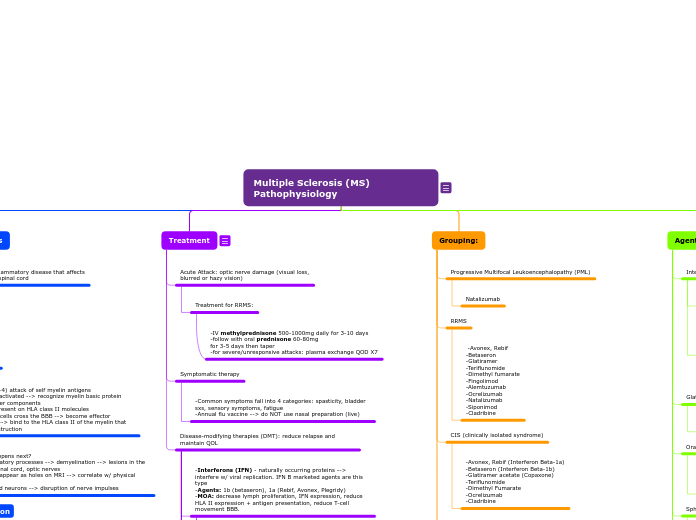Multiple Sclerosis (MS) Pathophysiology
The W's & H's
What: CNS inflammatory disease that affects
the brain and spinal cord
Who:
-15-45 yrs
-women
Why:
-geography
-age
-environment
-genetics
How:
1. T-cells (CD+4) attack of self myelin antigens
2. CD+4 cells activated --> recognize myelin basic protein (MBP) and other components
3. Antigents present on HLA class II molecules
4. Activated T-cells cross the BBB --> become effector macrophages --> bind to the HLA class II of the myelin that causes the destruction
What happens next?
-inflammatory processes --> demyelination --> lesions in the brain, spinal cord, optic nerves
-Lesions appear as holes on MRI --> correlate w/ physical disability
-damaged neurons --> disruption of nerve impulses
Presentation
Clinical Presentation:
A. Primary - direct result of neuronal damage
B. Secondary - occurs when primary are affected
C. Tertiary - daily life changes
D. Clinical course and prognosis
Primary signs+sxs:
-optic neuritis
-gait
-pain
-spasticity
-weakness
-ataxia
-speech problems
-fatigue
-sexual dysfunction
-bladder/bowel problem
-tremors
Diagnosis:
-MRI, CBC, U/A
Treatment
Acute Attack: optic nerve damage (visual loss,
blurred or hazy vision)
Treatment for RRMS:
-IV methylprednisone 500-1000mg daily for 3-10 days
-follow with oral prednisone 60-80mg
for 3-5 days then taper
-for severe/unresponsive attacks: plasma exchange QOD X7
Symptomatic therapy
-Common symptoms fall into 4 categories: spasticity, bladder sxs, sensory symptoms, fatigue
-Annual flu vaccine --> do NOT use nasal preparation (live)
Disease-modifying therapies (DMT): reduce relapse and maintain QOL
-Interferons (IFN) - naturally occurring proteins --> interfere w/ viral replication. IFN B marketed agents are this type
-Agents: 1b (betaseron), 1a (Rebif, Avonex, Plegridy)
-MOA: decrease lymph proliferation, IFN expression, reduce HLA II expression + antigen presentation, reduce T-cell movement BBB.
Betaseron
-reduces annual relapse rate/MRI burden of disease
-ADEs: inj site redness, flu-like, SOB, tachycardia, depression
-lower starting doses 1/4 to 1/2 for 1-2 mo. with increase to full dose @ 2 mo. to lessen flu-like.
Rebif (SQ), Avonex (IM), Pelgridy (SQ)
-disability reduction: 30-40% (higher than glatiramer)
-development of neutralizing antibodies (NAB)
-time-dependent for INFs as NAB inc at 6 mo. + develop as early as 3 mo. Happens w/ all agents.
Glatiramer (Copaxone)
-Copolymer 1
-MOA: MBP binding or mimics antigen actions of MBP, suppress T-cell activation and possibly migration
-ADEs: 10% chest tightness, flushing and dyspnea a few minutes after injection (<20mins). Flu-like/depression noted.
Fingolimod
-1st oral agent
-acts on S1P: responsible for lymphocyte release
-depletes CD4/8 lymphocytes in the blood
-does NOT inhibit T or B cells in organs or lymphocyte recruits
which means no immunosuppression or inc infection risk!
- approved for adults/peds
ADEs:
-CI w/ class I/II anti arrhythmic drugs; 2nd/3rd AV block
-1st dose observ req
-metabolized by CYP3A4, avoid inhibitors!!
Teriflunomide
-equal efficacy to IFNs and glatiramer
-prevents proliferation of peripheral lymphocytes
-inhibits CYP2C8, OATP1B1, OAT3. Induces CYP1A2
-warfarin use dec 25% INR
BLACK BOX WARNING:
-hepatotoxicity
-teratogenicity
Dimethyl fumarate
-Unknown MOA, NKDI
-preg C
Natalizumab
-MS/Crohn's disease
-Blocks leukocyte from crossing BBB
-Mono or given + IFNs
Alemtuzumab
-reserved for refractory pts > 2DMTs-watch before and after 2hrs
-monitor thyroid func q3m and then for 48mo after
last dose
Ocrelizumab
-first agent for primary progressive and relapsing MS
-give methylpred before
Ofatumumab
-RRMS + active secondary progressive disease in adults
-MOA: anti-CD 20 antibody
-CI: persons w/ active HBV infection
Siponimod:
-FDA for CIS, RRMS, and SPMS
-CYP2C9
Ozanimod:
-RRMS
-S1P receptor modulator
-DI w/ CYP2C8 inhibitors and inducers
-CI: Cardiac MI or class III/IV HF; 2/3rd AV block
Cladribine
-RRMS + SPMS
Mitoxantrone
-SPMS, PRMS, RRMS
-lifetime cumulative dose is 140mg/mm due to CHF
-cyclophosphamide + cyclosporine can be used
-depression major issue -> starts antidepressants w/ IFN tx
Grouping:
Progressive Multifocal Leukoencephalopathy (PML)
Natalizumab
RRMS
-Avonex, Rebif
-Betaseron
-Glatiramer
-Teriflunomide
-Dimethyl fumarate
-Fingolimod
-Alemtuzumab
-Ocrelizumab
-Natalizumab
-Siponimod
-Cladribine
CIS (clinically isolated syndrome)
-Avonex, Rebif (Interferon Beta-1a)
-Betaseron (Interferon Beta-1b)
-Glatiramer acetate (Copaxone)
-Teriflunomide
-Dimethyl Fumarate
-Ocrelizumab
-Cladribine
PPMS/SPMS (Primary/Secondary progressive type MS)
-Ocrelizumab (only one approved for both RRMS/PPMS)
When + a corticosteroid is needed:
Alemtuzumab
Start methylprednisone for 3 days and just prior to infusion
RRMS acute attack leading to optic nerve damage
IV methylprednisone QD for 3-10D followed by oral prednisone for 3-5D then taper
Agents by class:
Interferons:
Beta-1a
Avonex, Rebif
Beta-1b
Betaseron
Glatiramer Acetate
Copaxone
Oral Immunomodulators
-Dimethyl fumarate
-Teriflunomide
-Cladribine
Sphingosine-1-Phosphate (S1P) receptor modulators:
Fingolimod (1st oral agent)
Siponimod
Monoclonal Antibodies:
Ocrelizumab
Natalizumab
Alemtuzumab
CD20-Directed cytolytic antibodies
Ocrelizumab
Pyrimidine Synthesis inhibitor
Cladribine
